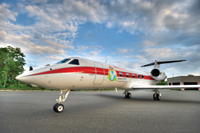
Features
Operations
Leading Edge: Renewing resources
If you want to highlight innovation in the international aerospace community, there’s no better place to do it than in the city of lights – specifically, the Paris International Air Show.
July 6, 2011 By Stacy Bradshaw
If you want to highlight innovation in the international aerospace community, there’s no better place to do it than in the city of lights – specifically, the Paris International Air Show.
With more than 2,000 exhibitors from 46 countries, the annual gathering is the pinnacle of the annual airshow circuit. Held June 20-26, this year’s event showcased some of the most advanced technology in aerospace, and front and centre was a strong commitment to enironmentally conscious air travel. Industry leaders showed off their green credentials with impressive presentations, demonstrating a worldwide commitment to reducing CO2 emissions remains a steadfast goal.

|
The “greening” of aviation’s greatest event kicked off in dramatic fashion two days before the doors opened with Honeywell’s dramatic transatlantic crossing by a Gulfstream G450 business jet to land at Le Bourget. The seven-hour journey across the pond from Morristown Airport in New Jersey closely followed the historic Atlantic crossing by Charles Lindbergh, and marked the first transatlantic journey using biofuel. The Honeywell-operated aircraft flew from North America to Europe, with a 50/50 blend of Honeywell “Green Jet Fuel” and petroleum-based jet fuel powering one of its Rolls-Royce Tay Mk 611-8C engines. The G450 was the world’s first business jet to be powered by a biofuel.
The G450’s transatlantic flight was followed by Boeing’s own historic crossing. The new 747-8F debuted in Paris, having made the transatlantic flight with all four of its General Electric GEnx-2B engines powered by a blend of 15 per cent camelina-based biofuel mixed with 85 per cent traditional kerosene fuel (Jet-A).
Gulfstream worked closely with Honeywell to ensure the viability of the company’s biofuel, which is derived from camelina, an inedible crop. The co-operative effort also supports the commitment many GA partners have to achieving the business aviation industry’s goals on emissions reductions, including carbon-neutral growth by 2020 and a reduction in total carbon emissions of 50 per cent by 2050, relative to 2005 levels. Alternative fuels could account for 40 per cent of these reductions, while the remaining improvements will come from technology and operations. (For more on biofuels and Canadian applications, see “A fuel of dreams,” pg. 16.)
Here in Canada, the commitment to reducing our environmental footprint is being revealed in any number of important areas of product development. Organizations such as the National Research Council, Nav Canada, Porter Airlines, Pratt & Whitney Canada, Bell Helicopter Textron Canada, Bombardier Aerospace, and countless others, are making concerted efforts to reduce their carbon footprint and implement new technologies to preserve the environment.
And it’s not all about environmental responsibility. As Sylvain Cofsky, executive director of the Green Aviation Research & Development Network (GARDN) points out, the pursuit of a green business strategy can produce plenty of green in revenue – especially given that aviation transports more than 2.3 billion annually and traffic growth is increasing five per cent annually. “The world’s 2,092 airlines have a total fleet of nearly 23,000 aircraft, and the replacement costs – or revenues – of new aircraft to enter fleet between now and 2020 is $1.3 trillion,” he notes.
GARDN is a business-led network of centres of excellence with a budget of more than $24 million over four years (2009-2013). Created by the federal government, its mandate is to promote environmental research in Canada in the area of sustainable aviation – the first Canadian aerospace initiative focusing on reducing the environmental footprint in this industry. Its first “Fly Green – Making Our Dreams A Reality” conference Feb. 23 at Ottawa’s Canada Aviation and Space Museum (see “Green with energy,” pg. 22) showcased cutting-edge green technologies, and brought to light important research in the area of sustainable aviation.
With key objectives ranging from fostering the development of technologies that will reduce aircraft noise and emissions in the vicinity of airports, to reducing the production of greenhouse gases by the aviation sector, GARDN is committed to applying a green-conscious approach to Canadian skies.
So, as the lights went out on another extravaganza in Paris, it was comforting to know organizations here and abroad continue to value the economic viability and environmental importance of a green-conscious approach.
| top data bursts… in this issue 1. 946 million. Number of litres of biofuel Rentech will produce annually (pg. 16). 2. US $3.7 billion. Value of business and private aircraft shipments in Q1 2011 (pg. 18). 3. Aviation industry has kept its carbon footprint under 20 million tonnes annually (pg. 23). 4. 21,000: Number of annual medical transports Ornge makes (pg. 33). 5. 300,000: Average price of a vintage aircraft (pg. 41). |